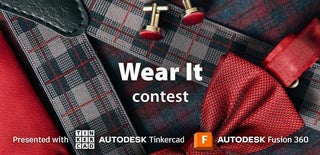Introduction: Homemade Confortable Shoes
Hello everyone.
having a sewing machine that I am learning to master and practicing 3D for a few years, I wanted to make my shoes as a challenge!
3D now makes it possible to print all kinds of technical materials such as flexible filaments.
this project explains what can be done and the mistakes to avoid if you want to make your own shoes!
Supplies
For this project, I used fabrics...
the interior fabric comes from a fabric store like you find on every street corner.
the exterior fabric comes from a porsche 944 rear seat (it is resistant and as a bonus it has porsche written on it)
then I used translucent orange TPU filament for the shoe frame
for the soles, I used filaflex recreus
the rest is classic like sewing thread, a sewing machine and a 3D printer
Step 1: 3D Design
designing the shoe frame:
i just draw my foot on a paper sheet then I used inkscape to turn my foot drawing into a vector drawing
I am using 123D design from autodesk to transform the vector drawing into a 3D shape which I will extrude and work on afterwards.
(It remains very efficient and allows me to use it offline to protect my computer from viruses and have maximum performance.)
I think that with fusion 360, it must be possible to better
Step 2: 3D Printing
this is starting to become important.
TPU requires slower print settings because the material is flexible but my machine allows me to keep the same settings as for PLA.
the filaflex requires a direct drive machine because in bowden the yarn settles in the tube...
it takes a print speed of 25mms maximum for the filament to have time to come out well
it is now that my project will help you...:
the TPU is flexible but still quite slippery and rigid.
it is a material that slides on the ground.
the filaflex looks like tire rubber and provides good grip
for my impressions of TPU chassis and filaflex sole I used 100% filling to avoid premature wear and tear
for the tpu insole I used a 30% filling to have a cushioned sole
Step 3: Sewing
In this section,
I managed to sew myself but it wasn't easy... I used a pair of converse that were too damaged as a sewing pattern
I took the assembly apart to see how it was done and I reproduced the converse seams as best I could
Step 4: Final Assembly
now comes the trickiest part.
having a small 3d printer I had to make the soles in two parts...
the tpu sticks very badly so I welded it.
a first time by putting the two parts to be assembled against a heated metal plate (which allows an assembly similar to the layers that come together during a print)
then sticking them together while they are still sticky
then for the finish of the assembly, I use a piece of filament:
I heat the two parts to be assembled at the same time and also the filament which softens and reinforces the weld (I put a video made for the example)
then I put my sewn fabrics in, adjusting and fixing for the first time with neoprene glue
then I sewed the fabric to the frame of the sole to solidify the whole
the shell is glued on the same principle as the chassis with a piece of filament added to the soldering iron

Participated in the
Wear It Contest













